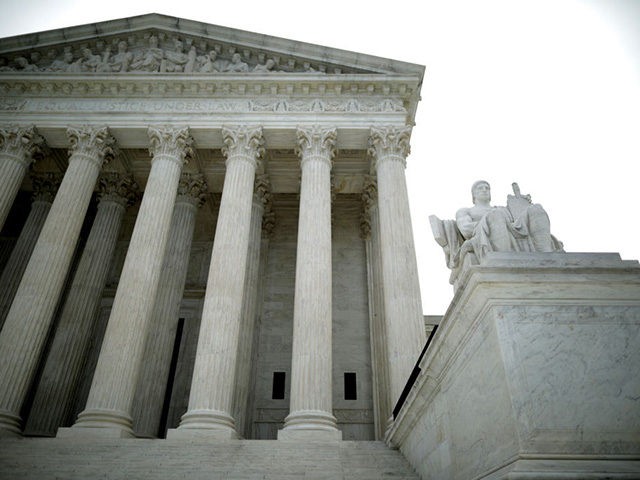The U.S. Supreme Court ruled Monday in favor of Oklahoma police officers who were accused of using excessive force after fatally shooting a man who raised a hammer behind his head, “and took a stance as if he was about to throw the hammer or charge at the officers.” The Court held that the officers are entitled to qualified immunity.
In August 2016, police officers Josh Girdner, Chase Reed, and Brandon Vick responded to a 911 call from Dominic Rollice’s ex-wife, Joy, who told a dispatcher that Rollice was in her garage, was intoxicated, and would not leave, the Supreme Court explained in a per curiam opinion.
Joy requested police assistance, adding that “it’s going to get ugly real quick” if officers do not arrive, the Court adds.
When the officers arrived at the scene, they spoke with Rollice in the doorway of the garage, where Rollice “expressed concern that the officers intended to take him to jail,” and then “began fidgeting with something in his hands.”
At that point, Officer Girdner asked if he could pat Rollice down for weapons, to which Rollice responded by refusing the request. Police body-camera footage shows Girdner then took one step toward the doorway, which caused Rollice to take one step back, the Court said.
While continuing to speak with the officers, Rollice “turned around and walked toward the back of the garage where his tools were hanging over a workbench,” the Supreme Court added.
The officers said after ordering Rollice to stop, the man kept walking, grabbed a hammer, and then turned around to face the officers. Rollice then held the hammer with both hands, “as if preparing to swing a baseball bat, and pulled it up to shoulder level,” the Court said.
The officers responded by backing up, drawing their guns, and yelling at Rollice to drop the hammer.
Instead of dropping the tool, Rollice proceeded to take “a few steps to his right, coming out from behind a piece of furniture so that he had an unobstructed path to Officer Girdner,” the Supreme Court explained.
“He then raised the hammer higher back behind his head and took a stance as if he was about to throw the hammer or charge at the officers,” the Court added. “In response, Officers Girdner and Vick fired their weapons, killing Rollice.”
Rollice’s estate later filed a lawsuit against Officers Girdner and Vick, claiming they were liable for violating Rollice’s Fourth Amendment right to be free from excessive force.
After a federal trial court held in a summary judgment that the officers’ use of force was reasonable, and that qualified immunity protected the officers from personal financial liability, a panel of the U.S. Court of Appeals for the Tenth Circuit reversed.
The appeals court cited to a Tenth Circuit precedent, saying the precedent meant an officer can be held liable for an objectively reasonable shooting if the officer’s reckless or deliberate conduct created a situation requiring deadly force.
The Denver-based court concluded that a jury could find Girdner’s initial step toward Rollice, as well as the officers’ subsequent “cornering” of him in the back of the garage, a form of reckless behavior that created the situation that led to the fatal shooting.
But the Supreme Court disagreed, stating, “The officers plainly did not violate any clearly established law,” and that qualified immunity protects “all but the plainly incompetent or those who knowingly violate the law.”
“We have repeatedly told courts not to define clearly established law at too high a level of generality,” the Supreme Court added.
“It is not enough that a rule be suggested by then-existing precedent; ‘rule’s contours must be so well defined that it is ‘clear to a reasonable officer that his conduct was unlawful in the situation he confronted,'” the Court said.
The Supreme Court went on to say that such specificity is “‘especially important in the Fourth Amendment context,’ where it is ‘sometimes difficult for an officer to determine how the relevant legal doctrine, here excessive force, will apply to the factual situation the officer confronts.'”
The justices also noted that the part of the prior Tenth Circuit case was dicta — meaning extra statements in the case that were not part of the case’s holding — and ruled that because the statements that made it dicta are not binding, they do not clearly establish legal violations for future cases like this one.
The Supreme Court added that therefore “not one of the decisions relied upon by the Court of Appeals” even “comes close to establishing that the officers’ conduct was unlawful.”
“The officers were thus entitled to qualified immunity,” the Supreme Court concluded.
The case is City of Tahlequah v. Bond, No. 20–1668 in the Supreme Court of the United States.
You can follow Alana Mastrangelo on Facebook and Twitter at @ARmastrangelo, and on Instagram.

COMMENTS
Please let us know if you're having issues with commenting.